Aviation against tanks (part of 12)
By the time Nazi Germany attacked the USSR, the Luftwaffe did not have well-armored attack aircraft comparable to Soviet IL-2, or specialized anti-tank aircraft. Within the framework of the concept of "Lightning War" to provide direct aviation support for the advancing units and to act on enemy communications was to be carried out by single-engine Bf 109E fighters, Bf 110 heavy fighters, Hs 123 attack aircraft and Ju 87 dive bombers. The enemy often used Ju 88 twin-engine dive bombers to strike at the front edge of Soviet defense.
By June 1941, the Bf 109E-4, E-7 and E-8 (“Emil”) modification fighters were no longer considered the most modern, and therefore they were mainly focused on performing drums. The conquest of air superiority and the escort of the bombers were to be occupied by Friedrichs - Bf.109F. However, such a division was largely conditional, although specialization did take place.
"Emil" was the first truly mass modification of the Bf 109 and in the middle of 1941, it was quite a combat capable fighter. Its maximum speed was 548 km / h. Bomb load could reach 250 kg. Built-in weapons consisted of two 7,92-mm machine guns and two 20-mm guns. However, the MG FF 20-mm guns mounted in the wing were not the height of perfection.
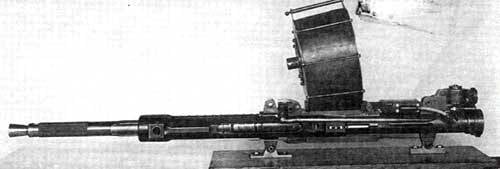
With a relatively low weight of -28 kg, the rate of fire was only 530 rds / min, the initial velocity of the armor-piercing projectile was about 600 m / s. The targeting range of the MG FF did not exceed 450 m, and armor penetration was insufficient even to fight lightly armored vehicles. Ammunition was limited as well - 60 shells per barrel. By all indications, except for the masses, the German 20-mm gun lost even to the most powerful Soviet ShVAK, and therefore in the second half of the war it gradually left the stage.
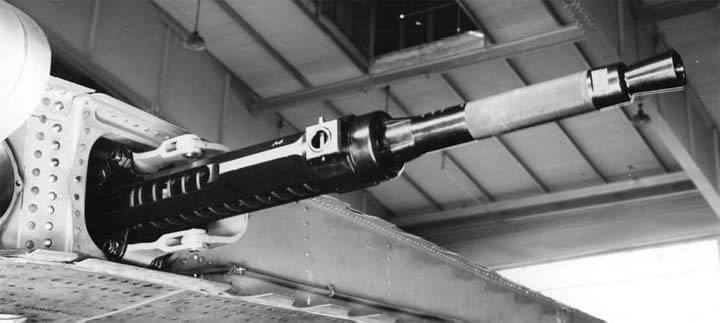
The single Messerschmitts operating on the Soviet-German front had an 6-mm steel armor plate mounted behind the tank and covering the entire cross section of the fuselage, armored glass and the armored seat of the pilot's seat. But the use of a liquid cooling engine and the lack of body armor on the cabin sides made the Bf.109 vulnerable even when fired from weapons rifle caliber. Therefore, an additional 109 mm armor plates were installed on the Bf 4E-8 part, which protected the pilot from below and behind. When carrying out attacks, high flight speeds and small sizes of Messer helped to avoid defeat by anti-aircraft fire.
German pilots were well aware of the vulnerability of their cars, and therefore, with anti-aircraft resistance, they tried not to make repeated attacks. In the domestic memoir literature it is often said that the "Messers" in the initial period of the war terrorized the columns of refugees and the retreating Soviet troops. Often they managed to smash the train echelons. But the high speed of flight sharply reduced the accuracy of the bombing and made it difficult to aim when firing machine guns and cannons at ground targets.
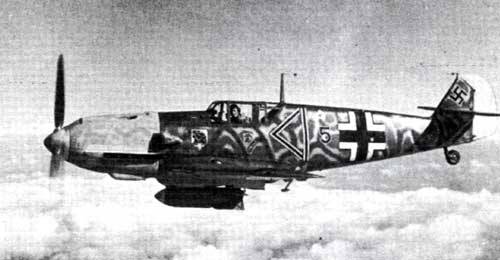
Anti-tank capabilities "Emil", despite a solid bomb load, were weak. After the failure of the blitzkrieg and the stabilization of the front line, the effectiveness of the Bf 109E as a fighter-bomber dropped sharply, and the losses, on the contrary, increased. Even with a fairly high speed of flight, the probability of getting a line from a large-bore machine gun, the DShK, sharply increased, and the Soviet infantry did not panic any longer and led concentrated fire from small arms at low-flying enemy aircraft. By the beginning of the 1943 of the year, the Bf.109E on the Eastern Front was practically gone, and the fighters of the Bf 109F and G modifications were massively used for strikes against ground targets.
History The combat use of heavy fighters Bf.110 on the Soviet-German front is in many ways similar to the combat career of Bf.109Е. After the Bf 110 fiasco as a fighter in the Battle of Britain, it was reclassified into attack aircraft. At the same time, the cockpit of the attack aircraft had 12 mm armor in front and 57 mm armored glass; the gunner was protected by 8 mm armor. On the side panels of the cabin used 35 mm bulletproof glass. The thickness of the bottom armor was 8-10 mm.
The offensive weaponry of the Bf 110 was powerful enough: two MG FF 20-mm cannons with 180 shells per barrel and four MG-7,92 17-mm machine guns with 1000 rounds of ammunition. The tail covered the shooter with the MG 7,92 15-mm machine gun.
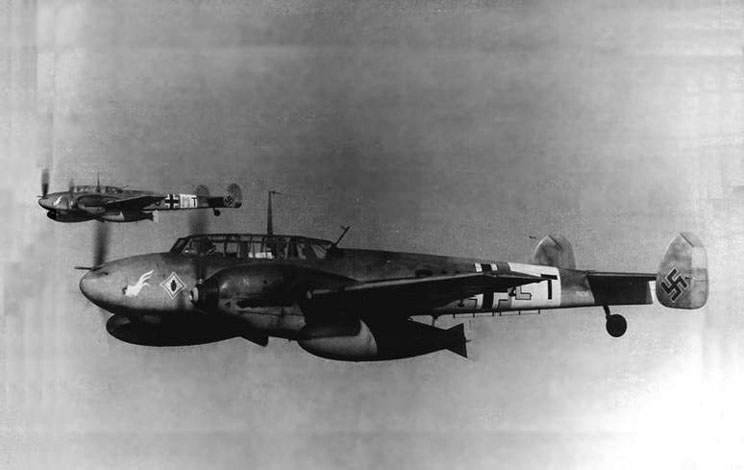
High-explosive bombs weighing up to 500 kg could be hung under the fuselage, 50 kg bombs were placed under the wing. The typical bomb load option was distributed as follows: 2 bombs for 500 kg and 4 for 50 kg. When finalizing the suspension units, the aircraft could even take 1000 kg bombs, while the weight of the combat load in the reloading variant could reach 2000 kg. In actions on areal poorly protected targets, 500 kg bomb containers AB 500, which were filled with 2 kg fragmentation bombs and opened after a discharge at a given height, turned out to be very effective.
Without a bomb load, at a height of 4000 m, the shock Bf 110F developed a speed of 560 km / h. The practical range was 1200 km. An attack aircraft with such characteristics could quite successfully act in the initial period of the war without fighter cover. Having got rid of the bombs, he had every chance to escape from the Soviet fighters. At the same time, attempts by Bf.110 pilots to conduct active air combat with single-engine fighters often ended in disastrous for them. The heavy twin-engine Messerschmitt with a take-off weight of 9000 kg was hopelessly lost to single-engine machines in terms of climb and maneuverability.
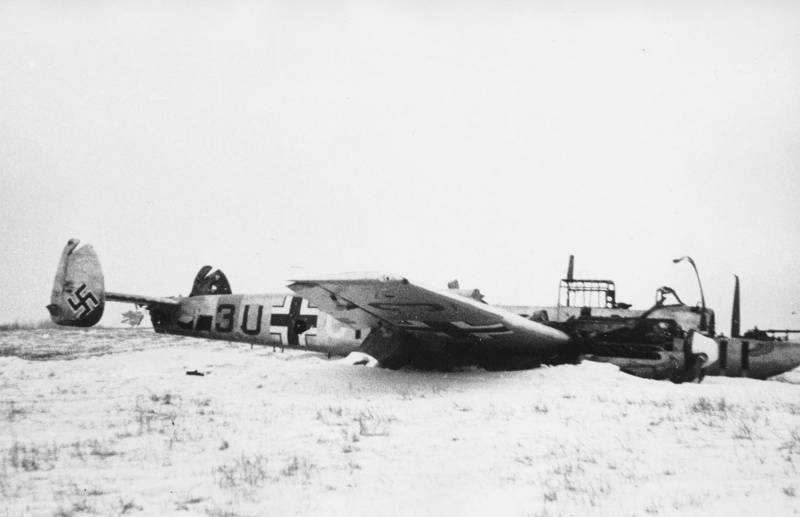
There is a case when a Soviet pilot on an I-153 in one air battle managed to shoot down two Bf 110. Having shot all the cartridges, the deputy commander of the squadron of the 127-IAP, senior politruk AS Danilov, with a ram attack, sent a third enemy plane to the ground.
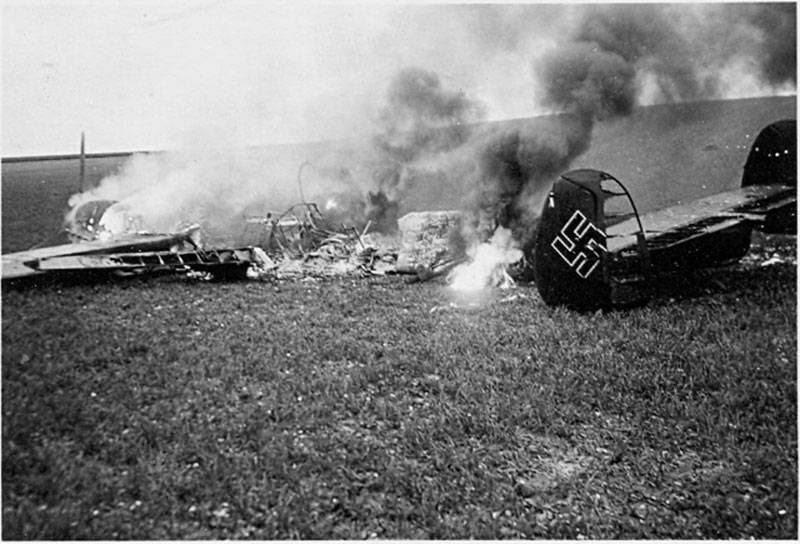
However, with proper tactics, the use of Bf 110 was a very good attack aircraft and did not carry much loss. Durable and robust airframe design, body armor and two engines made the aircraft resistant to combat damage. In any case, it was difficult to shoot down an airplane with rifle weapons. The long range of the flight made it possible to operate at a distance of several hundred kilometers from the front line, and a significant bomb load hit the entire spectrum of targets, including armored vehicles.
Since the MG FF 20-mm cannons were considered too weak, variants with the 1941-mm MK 30 and MK 101 and even with the 108-mm BK 37 gun began to appear at the end of 3.7.

The MK 30 101 mm aviation gun weighed 139 kg and had a rate of fire of 230-260 rounds / min., 500 g of a projectile containing 15 g of explosives fired from the barrel at a speed of 690 m / s at a distance of 300 m normal, could penetrate 25 mm armor plate. In mid-1942, the production of a lightweight armor-piercing projectile weighing 455 g with an initial speed of 760 m / s began, its armor penetration at the same distance increased to 32 mm. Around the same time, 355 g shell with a tungsten carbide core entered service. The initial velocity of the projectile exceeded 900 m / s. At a distance of 300 m, normal, according to German data, he pierced 75-80 mm of armor, and at an angle of 60 ° - 45-50 mm. The same armor-piercing shells were used in other German 30-mm aircraft guns. However, due to the chronic shortage of tungsten, carbide core shells did not produce much. Ordinary armor-piercing shells could with sufficient probability penetrate the armor of only light tanks, medium T-34 and heavy HF for them, as a rule, were invulnerable. However, the acronym damaging effect of carbide cores, even in the case of penetration of tank armor, was very modest. As a rule, everything ended up with a hole of small diameter forming in the armor, and the tungsten carbide core itself, after breaking, crumbled into powder.
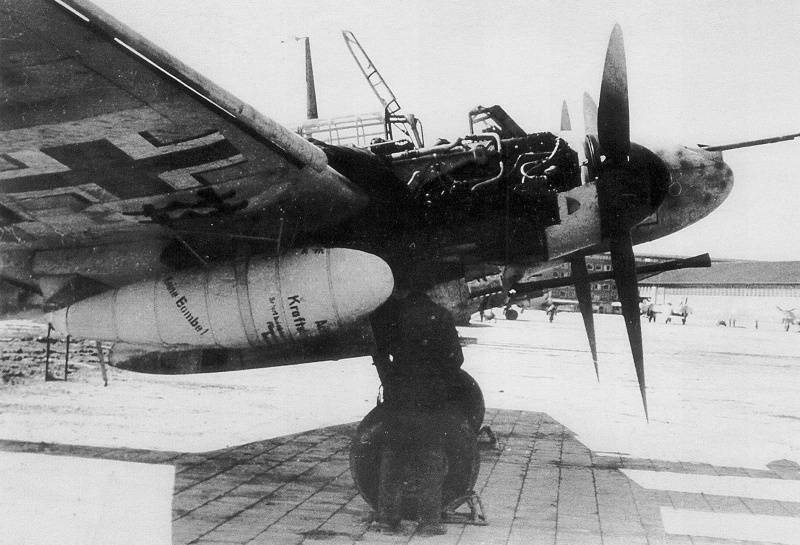
37-mm gun VK 3.7 was created on the basis of anti-aircraft machine 3.7 cm FLAK 18. The 37-mm projectile weighed twice as much as the 30-mm, which made it possible to dramatically increase the thickness of the pierced armor. A long-barreled cannon with a high initial velocity of a carbide-core projectile promised to be even more effective in the fight against armored vehicles. Since the 3.7 VC was used for charging, the responsibility for reloading the gun was placed on the onboard shooter. But the introduction of 30 and 37-mm guns on the Bf 110 coincided with the withdrawal of the aircraft from the assault aircraft. In 1942, the Germans began to feel an acute shortage of night fighters in the air units that defended Germany from British bombers, and therefore the remaining Bf.110 was decided to reassign to solve air defense tasks.
Now, few people remember about the German attack aircraft Hs 123, and in fact he actively fought until the second half of 1943, and even participated in the battles near Kursk. The archaic biplane, created in the middle of the 30, turned out to be very popular and the cars that survived the battles flew to full wear. Since the plane was considered obsolete by the end of the 30-x, only about 250 copies were built.
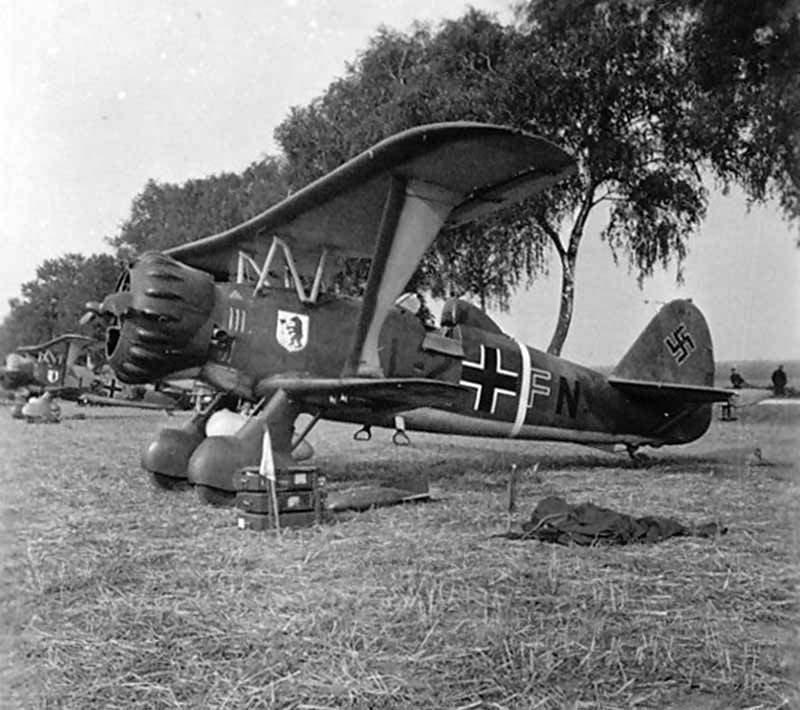
For its time, the attack aircraft had very good data, with a normal take-off weight of 2215 kg the Henschel took the kg of bombs on the 200. The combat radius of action in this case was 240 km - quite enough for an aircraft of direct aviation support and for actions in the enemy’s rear area. In the case when it was necessary to work on the front edge of the enemy's defense, the bomb load could reach 450 kg (one 250 kg aerial bomb on the central suspension unit + four 50 kg under the wing). Built-in weapons - two machine gun rifle caliber.
Star-shaped nine-cylinder engine air cooling VMW 132D power HP 880 allowed to develop in horizontal flight at an altitude of 1200 m speed 341 km / h. It approximately corresponded to the maximum speed of the Soviet fighter I-15bis. This speed was a practical limit for an aircraft with non-retractable landing gear, but unlike the Soviet biplanes, the Hs 123 was built from duralumin, which made it more resilient to combat damage and increased glider life. In general, in the hands of experienced pilots assault "Henschel" was a very effective strike aircraft. Although the pilot was initially protected by armor only at the rear, the combat survivability of the biplane was so high that he earned a reputation as “not killed”. Compared to other direct support aircraft, the combat losses of the Hs 123 were significantly lower. So, during the Polish company, much more modern dive bomber Ju 87 lost about 11% of those participating in hostilities, while at the same time 2 Henschel from 36 who took part in the battles was shot down by enemy fire. The rather high combat survivability of the Hs 123 was explained not only by the all-metal construction, but in front of the pilot it covered the air-cooled engine, which kept the combat damage well. In addition, in the initial period of the war, when German aircraft dominated the battlefield, the anti-aircraft cover of the Soviet troops was frankly weak, and the main anti-aircraft in the front line were quadruple anti-aircraft installations based on the Maxim machine gun. An important advantage of assault biplanes was their ability to make combat missions from muddy ground airfields, which other German aircraft could not do.
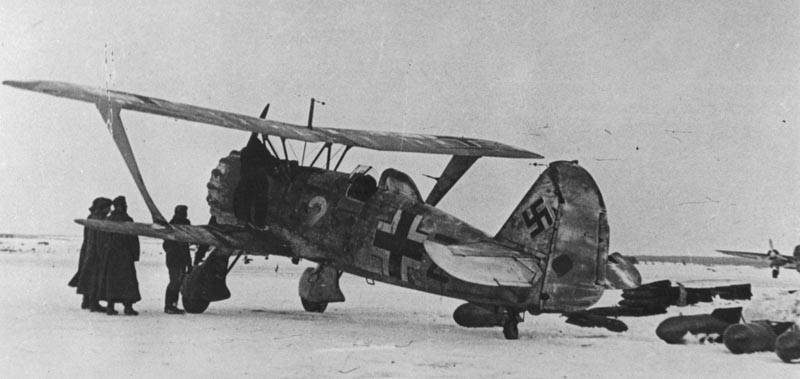
Although with respect to other types of combat aircraft operating on the Soviet-German front, the Hs 123A was relatively small, infantry commanders of all levels noted good accuracy and effectiveness of their air strikes. Due to its low flight speed and excellent maneuverability at low altitudes, Henschel bombed very accurately. He could be equally successful in the role of attack and dive bomber. There have been many instances when the Henschel pilots managed to hit 50 kg with bombs in single tanks.
In connection with the fair criticism of weak offensive weapons, starting from the summer of 1941, on the Hs 123, containers with MG FF 20-mm guns were suspended — this certainly did not greatly increase the anti-tank potential of the vehicle, but it increased efficiency against trucks and locomotives.
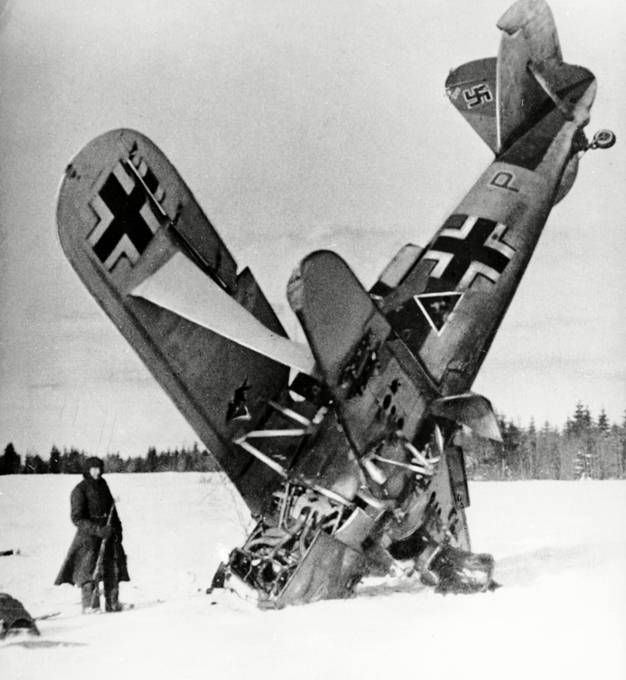
In the winter of 1941-1942. the remaining assault biplanes were overhauled and upgraded. In this case, the cockpit was protected by armor from the bottom and along the sides. Given the harsh winter conditions in Russia, the cabin was closed with a lantern and equipped with a heater. To compensate for the increased take-off weight, air-cooled engines BMW132K hp 960 hp were put on the upgraded attack aircraft. The MG 151 / 20 cannons were installed on a part of the machines in the wing. At the same time, the anti-tank capabilities of attack aircraft increased. 15-mm armor-piercing bullet of 72 g mass at a distance of 300 m along the normal penetrated 25 mm armor. A 52 g bullet with a hard-alloy core, fired at an initial speed of 1030 m / s, punched 40 mm armor under the same conditions. What is the real success of the "Henschel" with built-in guns is unknown, but given the fact that they were released a little, they could not have a particular impact on the course of the hostilities.
In 1942, the Hs 123 was used on the front even on a larger scale than a year ago. To increase their numbers at the front, the aircraft was withdrawn from flight schools and rear units. Moreover, the aircraft dumps were collected and restored suitable for further use Hensheli. A number of high ranks of the Luftwaffe called for the resumption of production of hopelessly outdated aircraft. All this, of course, did not come from a good life. Already in the winter of 1941, it became clear that the quick victory did not work, and the war in the East was delayed. At the same time, the Soviet Air Force and Air Defense recovered from the initial shock, the ground units and the military leaders of the Red Army gained some combat experience, and the Soviet industry began to rebuild on military tracks. In the Luftwaffe, on the contrary, there was a shortage of qualified pilots and aircraft. That is why it became so in demand easy to manage, unpretentious to maintain, durable and fairly effective attack aircraft Hs 123.
On the Soviet-German front, this aircraft actively fought until the second half of 1943. Good handling and high maneuverability allowed him, acting near the ground, to dodge the attacks of Soviet fighters. By the middle of the war, due to the increased power of the Soviet anti-aircraft artillery, the Henschel pilots tried not to go beyond the front line, their main goals were on the front lines. The inevitable loss and wear of the material part led to the fact that by the year 1944 in the first-line units of the Hs 123 attack aircraft there were no more. The small number of built Hs 123 is largely due to the fact that soon after the start of mass production of the Henschel, it was decided to adopt a more advanced diving bomber.
In the middle of the 30-x with increasing speed of flight of combat aircraft, it became clear that it was almost impossible to hit a point target with a horizontal flight with a single bomb. It was necessary either to repeatedly increase the bomb load, or to increase the number of bombers participating in the combat sortie. Both turned out to be too costly and difficult to implement in practice. The Germans closely followed the American experiments in creating a light dive bomber, and in the second half of 1933, the German Aviation Ministry announced a competition to develop its own dive-bomber. At the first stage of the competition it was supposed to create a relatively simple machine, on which one could get relevant experience and work out the combat techniques of using a diving bomber. The winner of the first stage of the competition was Henschel Flugzeug-Werke AG with its Hs 123. At the second stage, a combat aircraft with higher flight data and a maximum bomb load close to the 1000 kg should have entered service.
The winner of the second stage of the competition was announced by Junkers Ju 87. He made his first flight in the 1935 year - almost simultaneously with the Hs 123. It was a twin-engine monoplane with an “inverted gull” type wing and a non-retractable landing gear. Ju 87 is also known as Stuka - short for him. Sturzkampfflugzeug - dive bomber. Because of the non-retractable landing gear with large fairings, Soviet soldiers later called this plane a “laptier”.
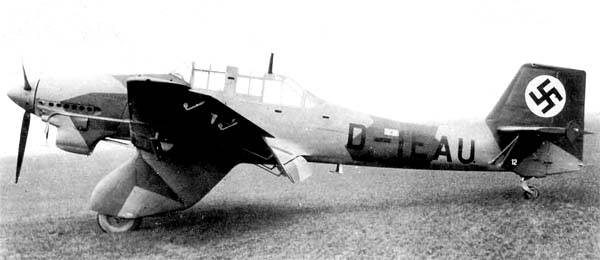
But because of the large number of technical solutions that had not been applied before, the aircraft was delayed, and the first Ju 87А-1 began to arrive in combat squadrons in the spring of 1937. Compared with the biplane Hs 123, the aircraft looked much more advantageous. The pilot and the gunner, who defended the rear hemisphere, sat in a closed cockpit. To limit the dive speed on the wing, there were “air brakes” in the form of a grill that rotated dive to 90 °, and the pilot’s combat work was greatly facilitated by the “dive machine”, which, after dropping bombs, ensured the aircraft exit from a peak with constant overload. A special device for automatic electrics rearranged the elevator trimmer, and this achieved the desired effect, while the effort on the control stick did not exceed normal for horizontal flight. Subsequently, an altimeter was included in the automatic withdrawal scheme from the peak, which determined the time of withdrawal, even if the bomb dropped did not occur. If necessary, the pilot, making greater effort on the handle, could take control. The search for the target was facilitated by the presence of an observation window in the cabin floor. The dive angle at the target was 60-90 °. In order to make it easier for the pilot to control the dive angle relative to the horizon, a special graduated grid was applied on the glazing of the cockpit canopy.
Aircraft of the first modification did not really become fighting vehicles, although they had a chance to accept baptism of fire in Spain. On the Antonov the engine was too weak, and the propeller group was flawed. This limited the maximum speed to 320 km / h, reduced the bomb load and the ceiling. Nevertheless, in Spain, the viability of the concept of a diving bomber was confirmed, which gave impetus to the improvement of the Stuck. In the autumn of 1938, the Ju 87B-1 (Berta) began mass production with a Jumo 211А-1 liquid-cooled engine Xnumx hp with liquid cooling. With this motor, the maximum horizontal flight speed was 1000 km / h, and the bomb load 380 kg (in overload 500 kg). Significant changes were made to the equipment and weapons. In the cockpit installed more advanced instruments and sights. The tail defended the 750-mm MG 7,92 machine gun in a ball mount with increased shelling angles. The offensive weaponry was reinforced with a second 15-mm MG 7,92 machine gun. At the disposal of the pilot device appeared Abfanggerat, providing a safe dive bombing. After entering the pilot’s headphones in a headset dive, a frequent signal was heard. After the passage of a pre-set bomb drop height, the signal disappeared. Simultaneously with pressing the bomb reset button, trimmers were rearranged on the elevators, and the installation angle of the propeller blades was changed.
Compared with the "Anton" dive bomber modification "Bert" became full-fledged combat aircraft. In December, the 1939 of the year began the construction of the Ju 87В-2 with the Jumo-211Da engine with the HP 1200 power. with a new screw and other changes. The maximum speed of this modification increased to 390 km / h. And in the overload could be hung 1000 kg bomb.
For the first time, Stuki against tanks successfully operated in France in 1940, demonstrating good combat effectiveness. But basically they played the role of "air artillery", acting on the requests of the ground forces - they smashed the fortifications of the enemy, suppressed artillery positions, blocked the approach of reserves and the supply of supplies. I must say that Ju 87 fully corresponded to the views of the German generals on the strategy of conducting offensive operations. Dive-bombers with precise bombing strikes swept away the batteries of anti-tank guns, firing points and resistance units of the defending enemy on the way of tank "wedges". According to German data, in terms of fighting 1941-1942. German dive bomber and attack aircraft could destroy and disable up to 15% of the total number of targets on the battlefield.
By the middle of 1941, the Luftwaffe had a streamlined aircraft control system over the battlefield and interaction with ground forces. All of the shock German aircraft had high-quality, reliable radio stations, and the flight crew had good skills in using airborne radio for control and guidance on the battlefield. Aircraft operators who are in combat formations of the ground forces had practical experience in organizing aviation control over the battlefield and targeting ground targets. Directly to accommodate the aircraft gunners, special radio-equipped armored vehicles or command tanks were used. When enemy tanks were discovered, they were often subjected to a bombing attack, even before the German forces could attack.
"Stuck" was the ideal strike aircraft of the battlefield in the initial period of the war, when German aircraft dominated the air and the ground air defense of the Soviet forces was weak. But the German dive bombers turned out to be a very tasty target for Soviet fighters, even for the "old men" of the I-16 and I-153. In order to break away from the Ju 87 high-speed data fighters, it was not enough, and weak armament and insufficient maneuverability for conducting air combat did not allow to effectively defend themselves in air combat. In this regard, to accompany the dive bombers, we had to allocate additional fighters. But the loss of Ju 87 began to grow from anti-aircraft fire. With a shortage of specialized anti-aircraft weapons, the Soviet command paid great attention to the training of personnel of line infantry units for firing personal firearms at air targets. In the defense for light and heavy machine guns and anti-tank guns, special positions were equipped with home-made or semi-handicraft anti-aircraft guns, on which dedicated calculations were constantly on duty. This forced "self-activity" gave a certain effect. Taking into account the fact that the Ju 87 dive bomber did not have special armor, often one rifle bullet that hit the engine radiator, it was enough for the aircraft not to return to its airfield. Already in the autumn of 1941, German pilots noted an increase in losses from anti-aircraft fire when striking the leading edge. During intensive bombardment from the ground, pilots of dive bombers tried to increase the height of the bomb dropping and reduced the number of hits on the target, which of course could not but affect the effectiveness of air strikes. As the Red Army air forces saturate with new types of fighters and the anti-aircraft cover was reinforced, the effectiveness of the Laptezhnik actions dropped sharply, and the losses became unacceptable. Until a certain moment, the German aviation industry could make up for the loss of technology, but already in 1942, there was a shortage of experienced flight personnel.
At the same time, the command of the Luftwaffe was not ready to abandon a fairly effective dive bomber. Based on the experience of hostilities, a total modernization of the bomber was carried out. To enhance flight data on the Ju 87D (“Dora”), which entered the front at the start of the 1942 of the year, they installed a Jumo-211P engine with an 1500 hp power. The maximum speed at the same time was 400 km / h, and the bomb load in the overload variant increased to 1800 kg. To reduce vulnerability to anti-aircraft fire, local booking was strengthened, which was very different depending on the production series.
So, on the Ju 87D-5 model, the total armor weight exceeded 200 kg. Bookings in addition to the cab were: gas tanks, oil and water radiators. This modification, which entered the army in the summer of 1943, had a pronounced assault specialization. The maximum bomb load was limited to 500 kg, instead of machine guns in the elongated wing, 20-mm MG 151 / 20 guns with ammunition from 180 shells per barrel appeared and the air brakes were dismantled. Containers with six MG-7,92 machine guns or two MG FF 81-mm guns could be additionally suspended on the external units under the wing. The reinforcement of defensive armament occurred due to the pairing of 20-mm caliber 81Z, designed for the defense of the rear hemisphere. However, in the face of the loss of air supremacy, the Stuki assault variants turned out to be unviable.
Within this cycle, the aircraft of the Ju 87G-1 and G-2 (“Gustav”) modifications are of the greatest interest. These machines are based on the Ju 87D-3 and D-5 and, as a rule, were converted from combat aircraft into field workshops. But part of the Ju 87G-2 anti-tank attack aircraft were new, they differed from the Ju 87G-1 modification with a larger wing span. Brake pads were absent on all machines. The main purpose of "Gustav" was the fight against Soviet tanks. For this attack aircraft armed with two long-barreled 37-mm guns VK 3.7, which had previously been used on aircraft Bf.110G-2 / R1. On a small part of the aircraft modified Ju 87G-2 preserved 20-mm wing guns MG151 / 20. But such airplanes were not popular among pilots because of the too noticeable drop in flight performance.
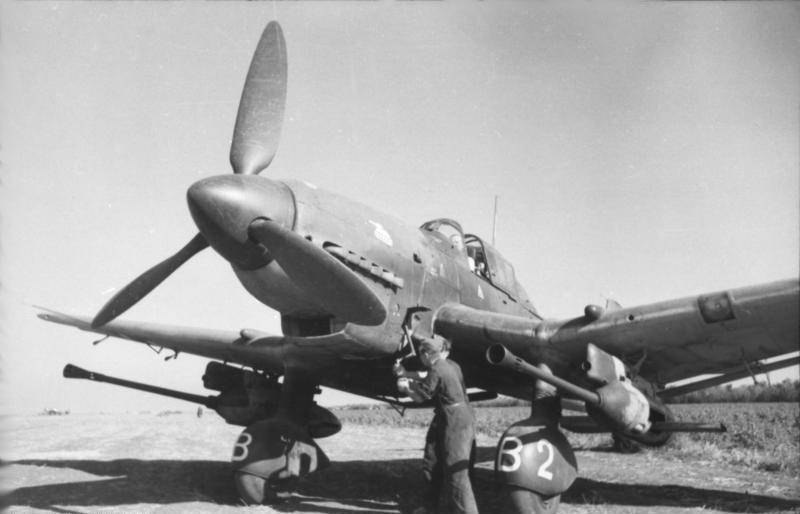
The anti-tank variant “Stuki” with 37-mm guns turned out to be frankly controversial. On the one hand, long-barreled guns, low flight speed, good stability and the ability to attack armored targets from the least protected side made it possible to fight armored vehicles. On the other hand, in view of the increased frontal resistance of the guns and the separation of heavy loads on planes, the artillery version became more inert than the dive bombers, the speed decreased by 30-40 km / h.
The plane was no longer carrying bombs and could not swoop with large angles. The 37-mm VK gun 3.7 itself, weighing with a gun carriage and projectiles over 300 kg, was not very reliable, and the ammunition load did not exceed the 6 projectiles per gun.
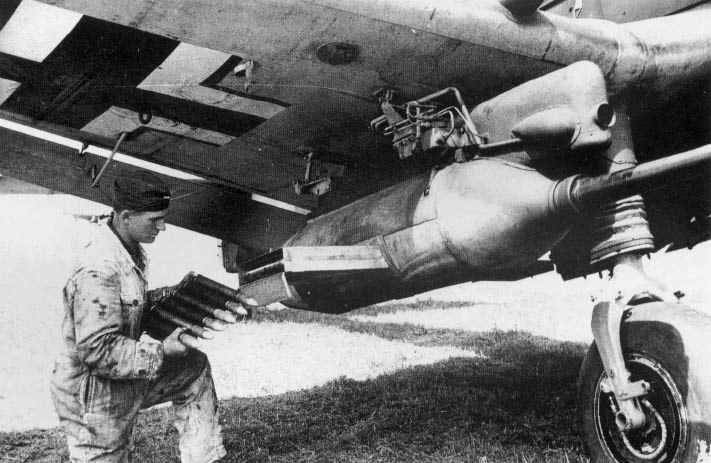
However, the low rate of fire of the guns did not allow in one attack to shoot at the target all the ammunition. In view of the strong recoil when shooting and the placement of guns, the aiming was lost by the emerging dive moment and the strong buildup of the aircraft in the longitudinal plane. At the same time, keeping the line of sight on targets during firing and introducing amendments to the aiming was a very difficult task, accessible only to highly qualified pilots.
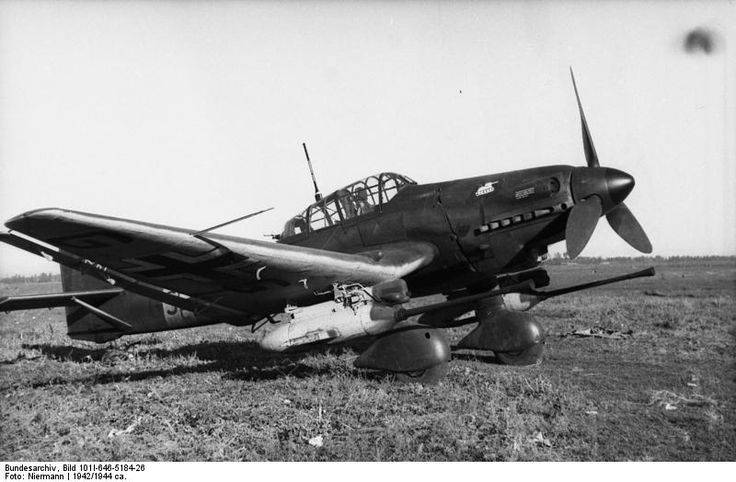
The most famous pilot flying on the anti-tank version of Stuck was Hans-Ulrich Rudel, who, according to German statistics, made 2530 combat missions in less than four years. Nazi propaganda attributed to him the destruction of 519 Soviet tanks, four armored trains, 800 vehicles and locomotives, the sinking of the Marat battleship, cruiser, destroyer, 70 small ships. Rudel allegedly bombed 150 positions of howitzer, anti-tank and anti-aircraft batteries, destroyed several bridges and pillboxes, shot down Soviet fighter planes and 7 attack aircraft Il-2 in air combat. At the same time, he himself was hit by anti-aircraft fire 2 times, at the same time he made forced landings several times. He was captured by Soviet soldiers, but fled. He was wounded five times, two of them hard, continued to make combat missions after the amputation of his right leg below the knee.
At the very beginning of his flight career, Rudel did not shine with special flight talents, and at one time the command was even going to remove him from flying due to poor training. But later, thanks largely to his luck, he managed to stand out among the pilots of the dive bombers. Although Rudel remained a convinced Nazi until the end of his life, he was surprisingly lucky in war. Where his comrades perished, this damn lucky pilot managed to survive. At the same time, Rudel himself repeatedly demonstrated examples of personal courage. It is known that he almost died when he tried to take out the crew of the wounded Junkers who had made an emergency landing on the territory occupied by Soviet troops. Having picked up a combat experience, the Stuki pilot began to demonstrate high combat results. Although he was persistently offered more modern types of combat aircraft, Rudel for a long time preferred to fly at a slow Ju 87G. It was on the attack aircraft with 37-mm guns Rudel achieved the most impressive results. Acting at low altitude, the pilot purposefully fought with Soviet tanks. His favorite tactical technique was the T-34 attack from the stern.
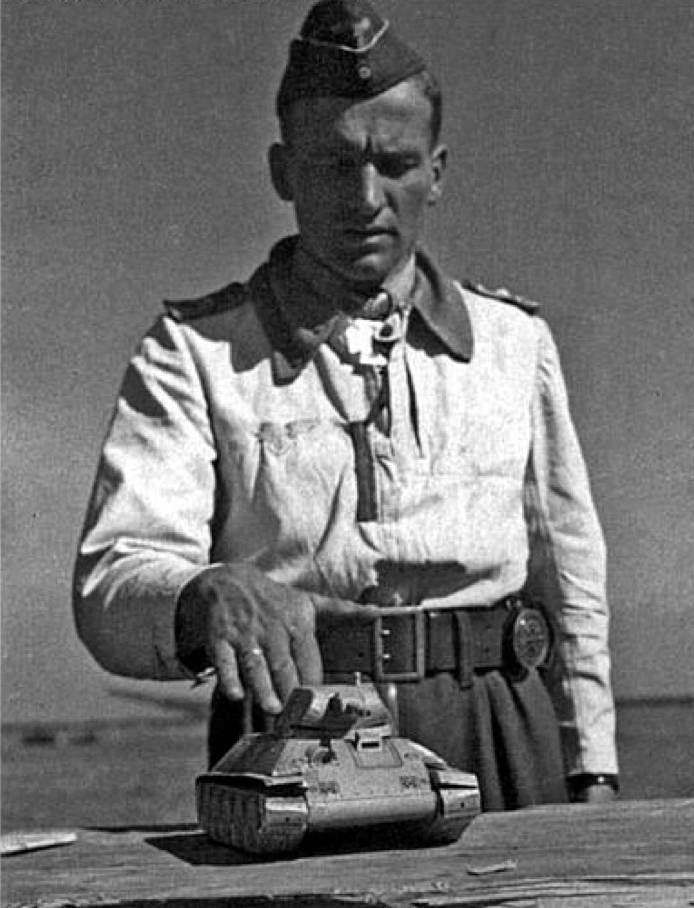
Hans-Ulrich Rudel demonstrates his method of attacking Soviet tanks on a T-34 model
Regarding Rudel’s combat scores on the Internet, many copies were broken. For the sake of justice, it is worth recognizing that many Russian historians consider Rudel’s achievements to be greatly overestimated, as, indeed, the combat accounts of most German asses. But even if Rudel destroyed at least one-fifth of the tanks for which he claims - this would certainly be an outstanding result. Rudel's phenomenon also lies in the fact that other German pilots who were flying on attack planes and dive bombers didn’t even come close to getting close to its results.
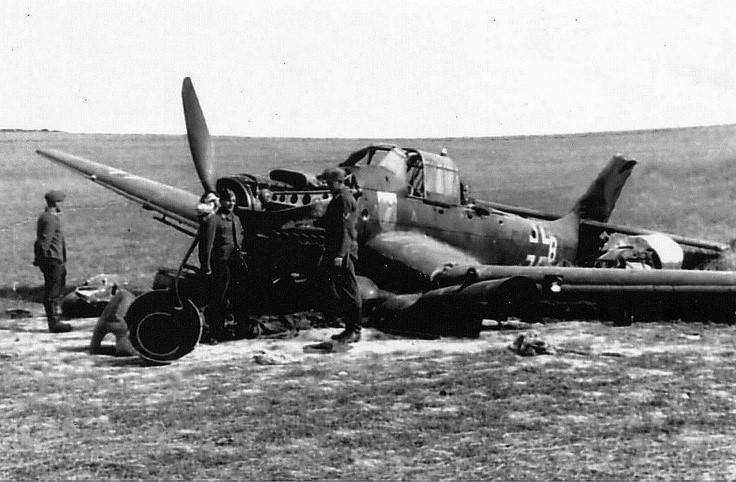
After 1943, the Ju 87, due to its vulnerability, became quite rare on the Soviet-German front, although its combat use continued until the spring of the 1945 year.
On the battlefield, in addition to specialized attack aircraft and dive bombers, "work" was repeatedly noted from low altitudes and from the flying flight of the twin-engined bomber Ju 88 and He 111, which bombarded and bombed the battle formations of the Soviet units. This took place in the initial period of the war, the year the Luftwaffe planes almost smoothly ironed our front edge and near rear. However, the Germans were forced to return to a similar practice in the final period of the war. It did not help to stop the offensive outburst of the Soviet troops, but the losses in the German bombers turned out to be very significant. For strikes against Soviet troops, even heavy night fighters Ju 88C were used, which were built on the basis of the Ju 88А-5 bomber.
Heavy fighters Ju 88C had a frontal armored glass and armored nose. Armament on different versions could vary greatly. Offensive armament usually consisted of several 20-mm guns and 7,92-mm machine guns. On the external nodes there was a possibility of suspension up to 1500 kg of bombs. The maximum ground speed was 490 km / h. Practical range - 1900 km.
At the end of 1941, the Wehrmacht command expressed a desire to get an anti-tank aircraft with a powerful weapon capable of destroying enemy medium and heavy tanks with a single shot. The work went slowly, and the first batch of 18 Ju 88P-1 with 75-mm gun XK NUMX VK under the cab and enhanced armor was transferred to the troops in the fall of 7.5 year. The aircraft installed a version of the anti-tank gun PaK 1943 with a barrel length in 40 calibers adapted for use in aviation. A semi-automatic horizontal wedge tool reloaded manually. In the 46-mm aircraft cannon could use the entire range of ammunition, applicable in anti-tank guns. To reduce recoil gun equipped with a muzzle brake. The rate of fire of the 75-mm gun was not high, during the attack the pilot managed to make no more than 75 shots. The gun and the large-sized fairing greatly increased the drag of the Ju 2Р-88 and made the aircraft very difficult to drive and vulnerable to fighters. The maximum ground speed dropped to 1 km / h.
The combat tests of the Ju 88P-1 took place on the central sector of the Eastern Front. Apparently, they were not very successful, in any case, information about the combat successes of tank destroyers with 75-mm guns could not be found.
The low combat effectiveness of heavy attack aircraft with a 75-mm cannon is due to their great vulnerability, excessive recoil and low rate of fire of the gun. To increase the practical rate of fire, the development of an electropneumatic automated mechanism for discharging shells from a radial magazine was carried out. The practical rate of fire of an instrument with an automatic loader was 30 rds / min. There was at least one twin-engine Junkers with an 75-mm automatic cannon. Subsequently, the installation of the 7.5 VK guns on the Ju 88 assault variants was refused, preferring to replace them with less powerful, but not so heavy and cumbersome 37-mm VK 3.7 and 50-mm VK 5. Guns of smaller caliber had a higher rate of fire and not so devastating impact. They were more suitable for use in aviation, although they were not ideal.
Following the Ju 88P-1, the “eighty-eighths” appeared, armed with two 37-mm X-guns. The first to be tested in June 3.7 of the year was the Ju 1943Р-88. However, representatives of the Luftwaffe did not accept the level of cockpit security. The next version with enhanced armored protection was designated Ju 2Р-88. The plane was tested, but whether this option was built serially unknown.
One aircraft with 37-mm guns was converted to install 50-mm guns XK 5. The Aviation 50-mm automatic cannon was created by reworking a KwK 60 tanked 39 semi-automatic tank gun with a vertical wedge gate.
The gun was powered from a closed metal tape on an 21 projectile. Sending projectile was carried out using an electropneumatic mechanism. Because of this, the rate of fire was 40-45 rds / min. With a good practical rate of fire and reliability, the entire artillery system was very heavy and weighed about 540 kg. The gun had a high armor penetration. At a distance of 500 meters, an armor-piercing projectile with a mass of 2040 g, ejected from the barrel at a speed of 835 m / s, pierced 60 mm armor at an 60 ° meeting angle. A shell with a hard-core 900 g mass and an initial speed of 1189 m / s under the same conditions could penetrate 95 mm armor. Thus, an attack aircraft, armed with a 50-mm gun, could theoretically fight medium tanks, attacking them from any direction, and the heavy tanks were vulnerable to firing from the stern and aboard.
At the beginning of 1944, deliveries of the Ju 88Р-4 heavy attack aircraft began with the 50-mm gun. Different sources indicate different numbers of built instances: from 32 to 40 machines. Perhaps we are also talking about experienced and aircraft refitted from other modifications. Part of the "eighty-eighths" was also armed with R4 / M-HL Panzerblitz 2 missiles with a cumulative warhead.
Due to the small number of Ju 88Ps built, it is difficult to estimate their combat effectiveness. Machines with heavy artillery weapons could act effectively in the initial period of the war, but then the main tasks of destroying ground targets were successfully solved by dive bombers and fighter-bombers. After the Germans lost air supremacy and the multiple growth of the power of the Soviet tank armies, heavy attack aircraft operating during the day over the battlefield were doomed to catastrophic losses. However, the Ju 88 was not the only multi-engine Luftwaffe aircraft on which it was supposed to mount guns with a caliber larger than 37-mm. So, 50 and 75-mm guns were supposed to arm a heavy attack aircraft, which was created on the basis of the long-range bomber He 177.
The plane, which received the designation He 177 A-3 / R5, was used to fight Soviet tanks and suppress Soviet air defense at Stalingrad, during an operation to unlock Field Marshal Paulus, surrounded by the 6 Army. In this version, the 5 He 177 A-3 bombers were retooled. But the surrounded 6-I army surrendered before the installation of heavy weapons was completed and the aircraft returned to their original form.
To be continued ...
Based on:
http://grafiq.ru/junkers-ju-87d-stuka/
http://www.soldiering.ru/avia/airplane/ww2/battle-plane.php
http://www.airwar.ru/weapon/guns/mk101.html
http://www.achtungpanzer.com/gen9.htm
https://www.aviarmor.net/aww2/aircraft/germany/he177.htm
Start-Verlag, Bad Zwischenahn. Luftwaffe im Focus
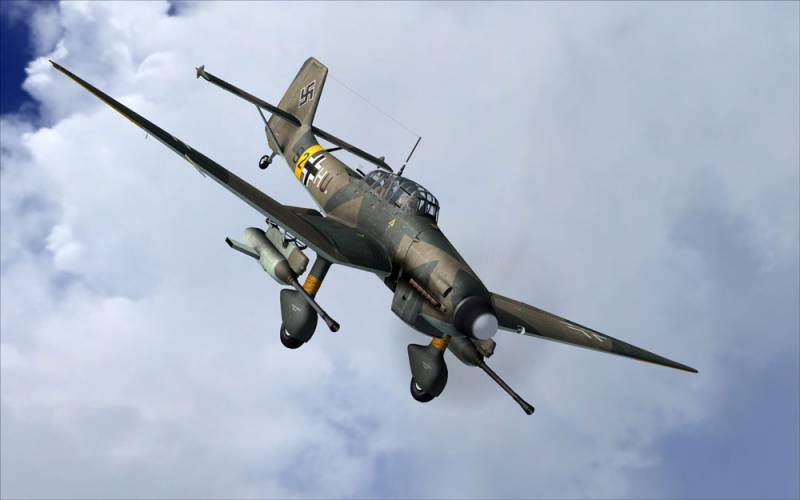
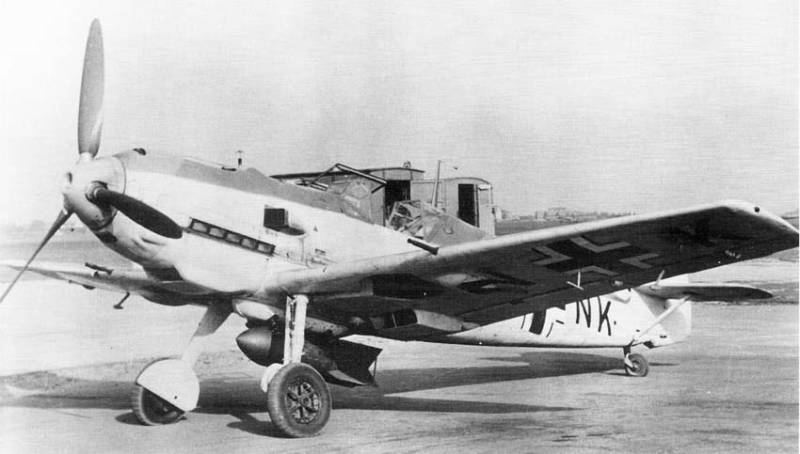
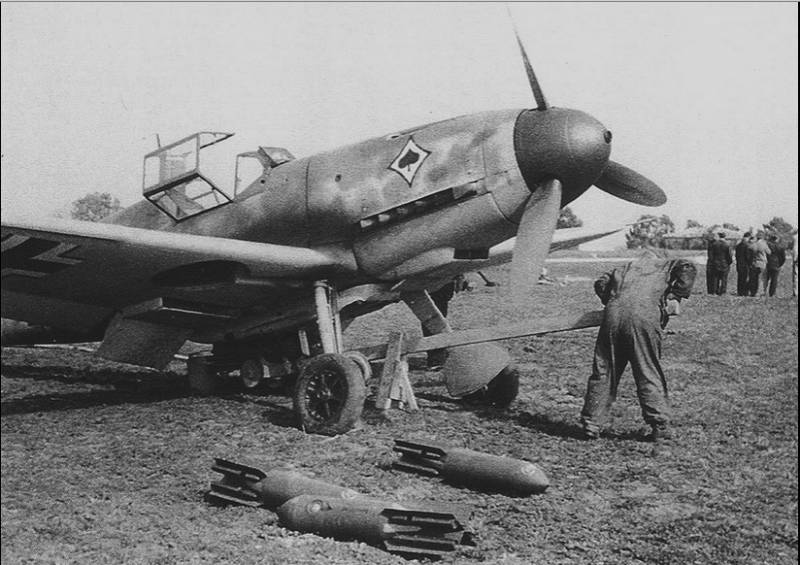
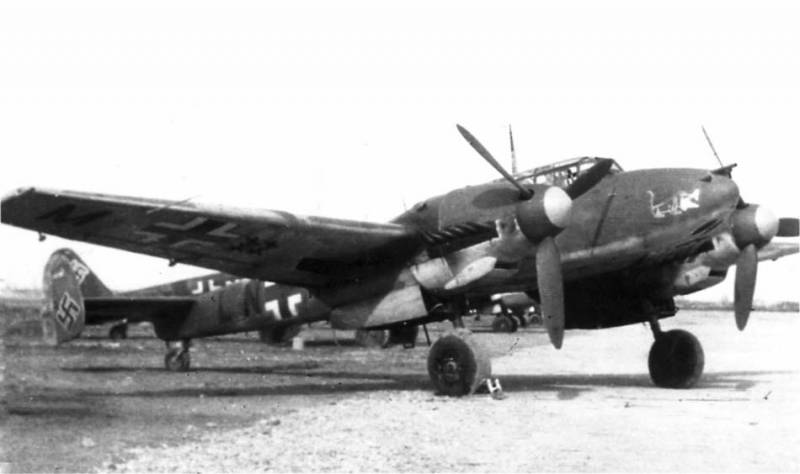
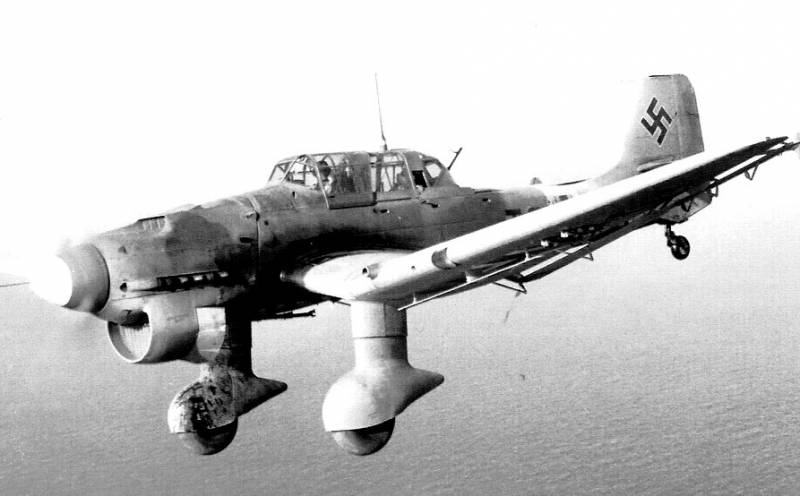
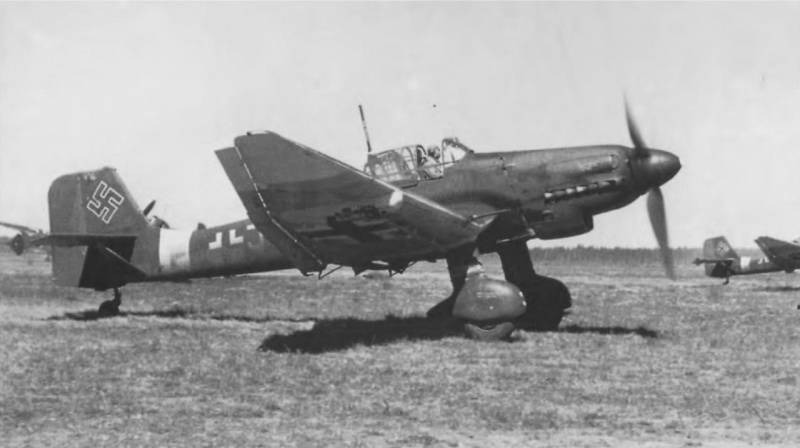
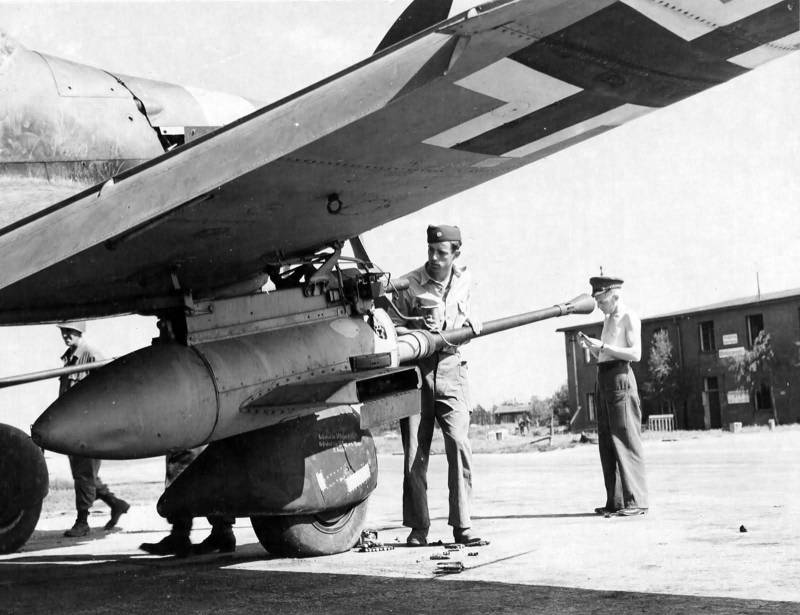
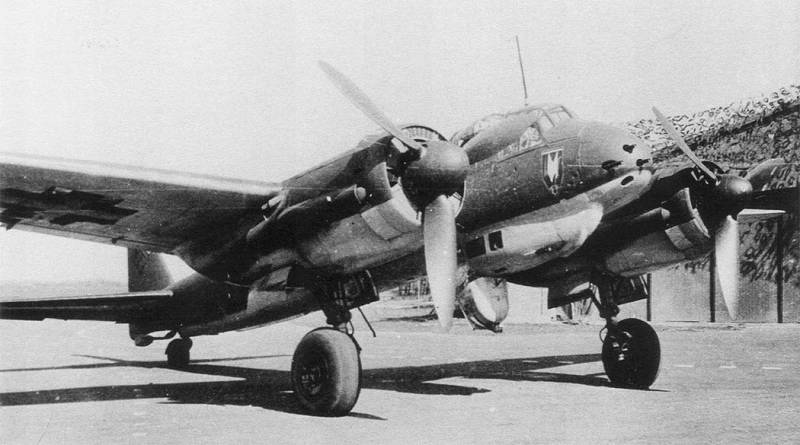
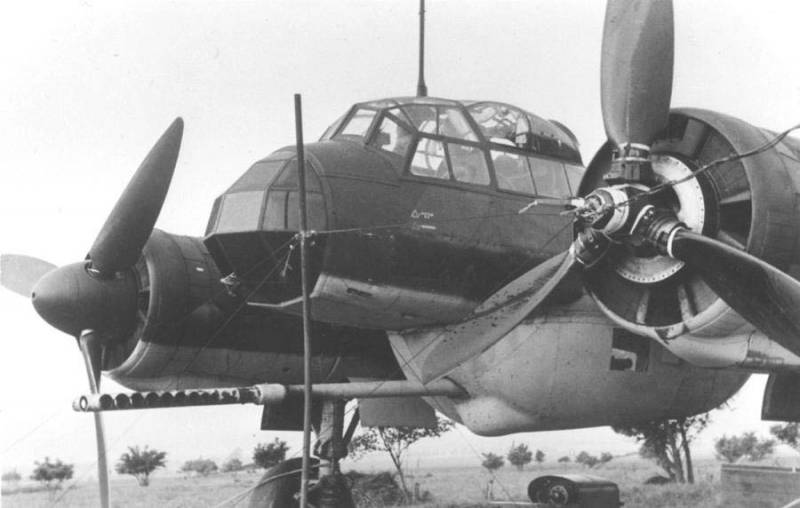

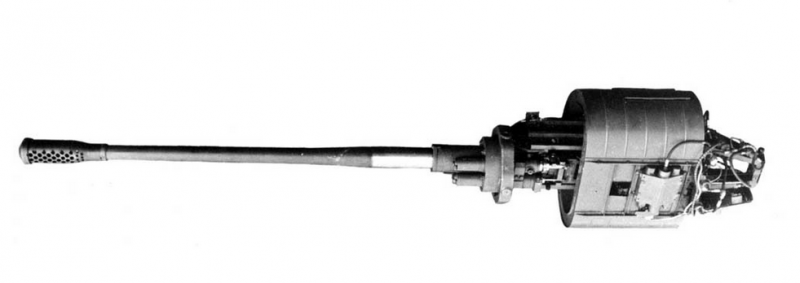
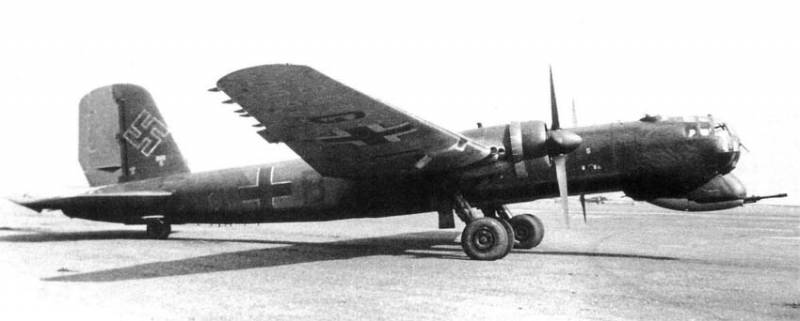
Information